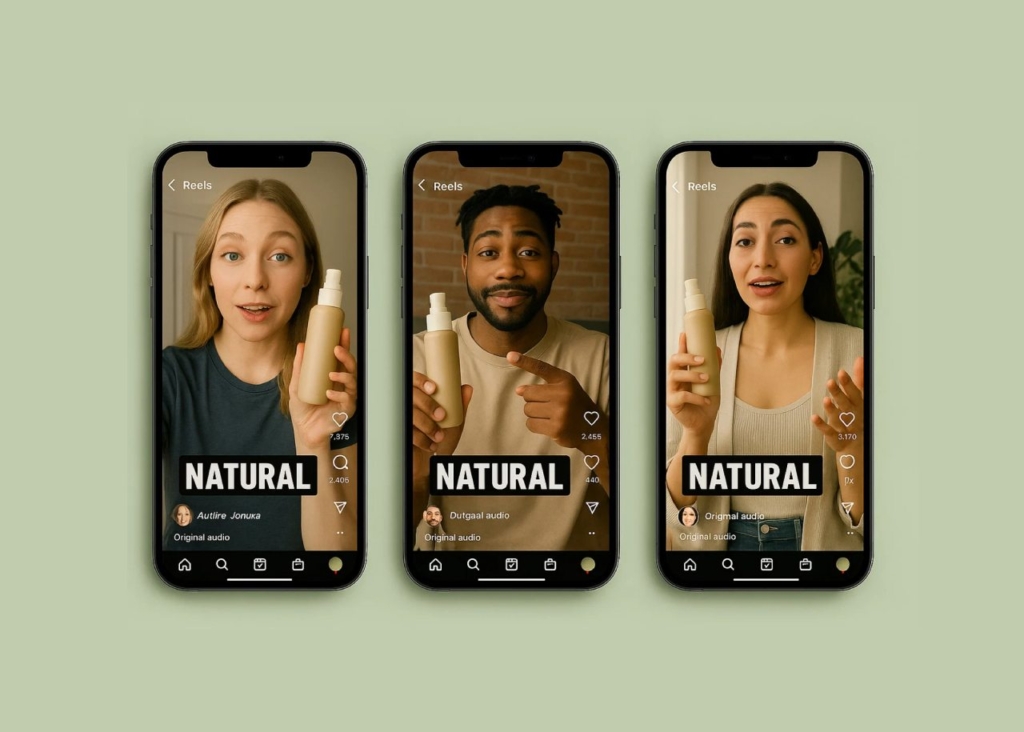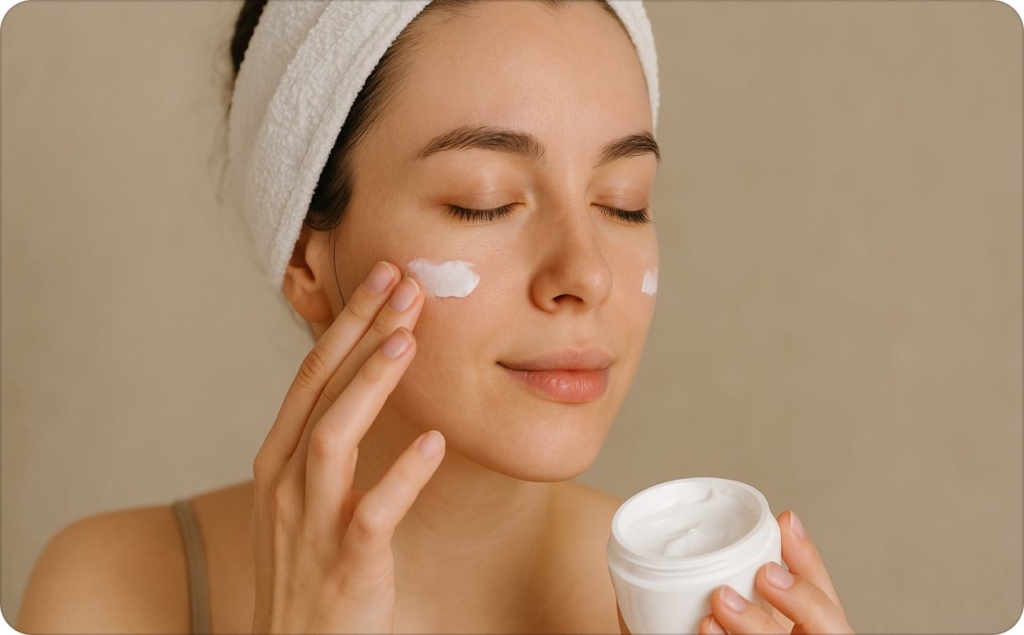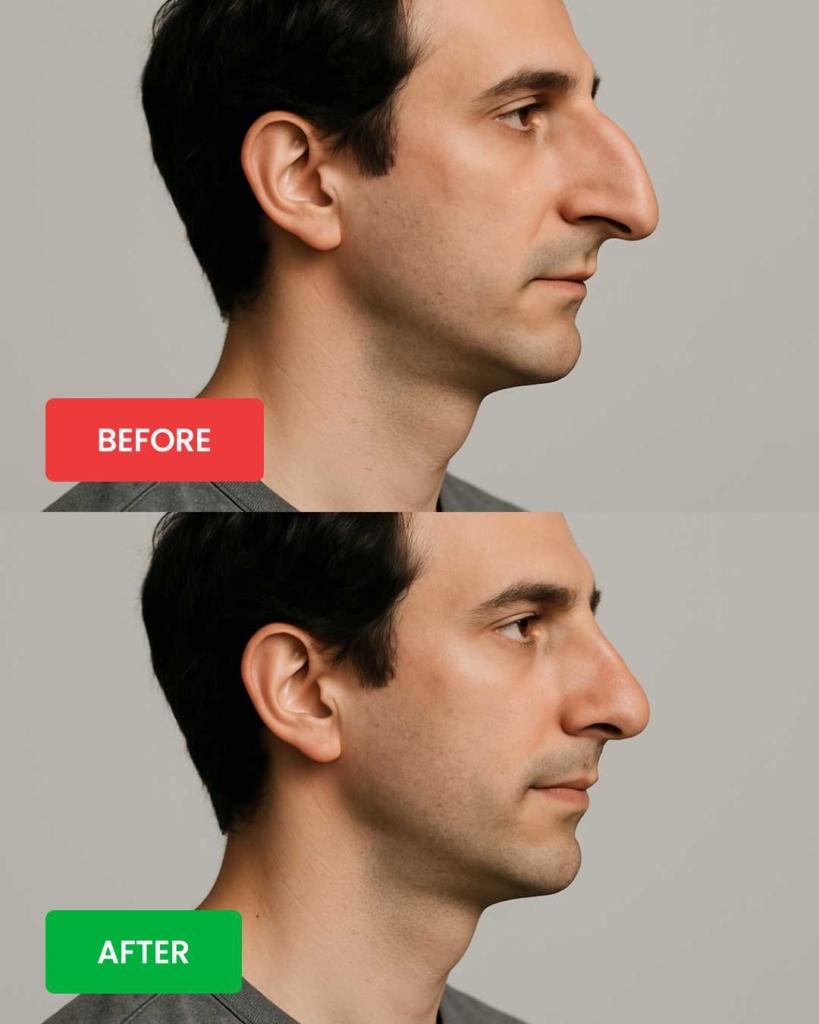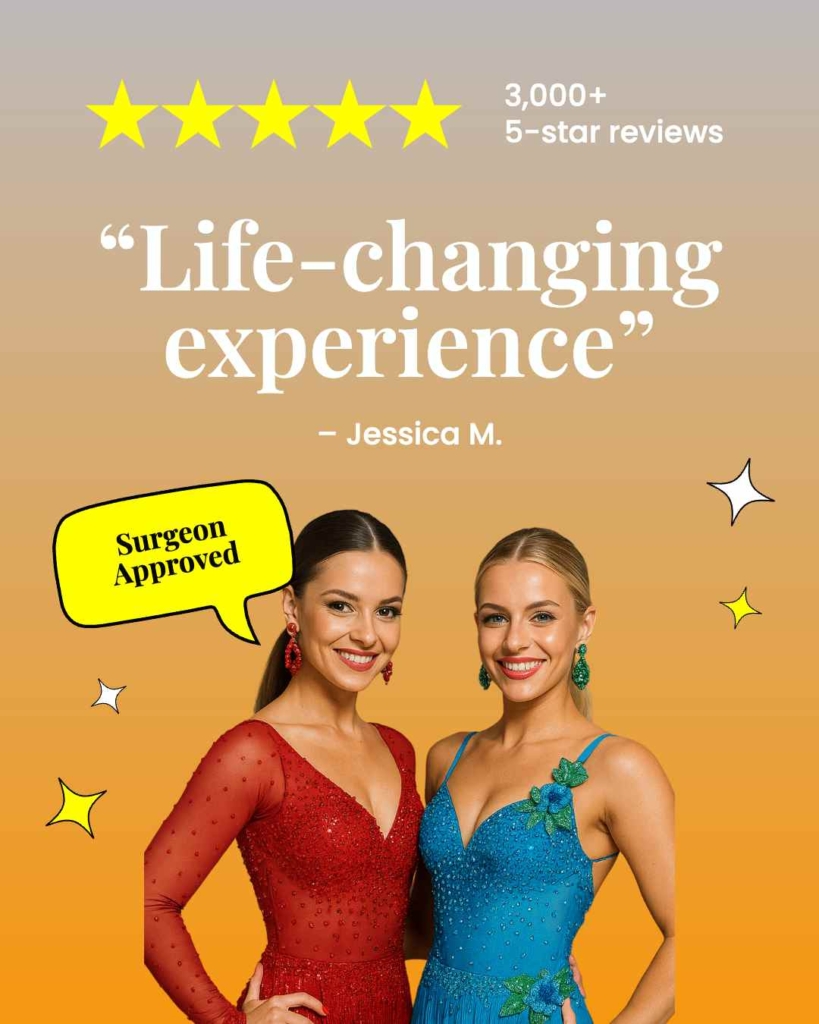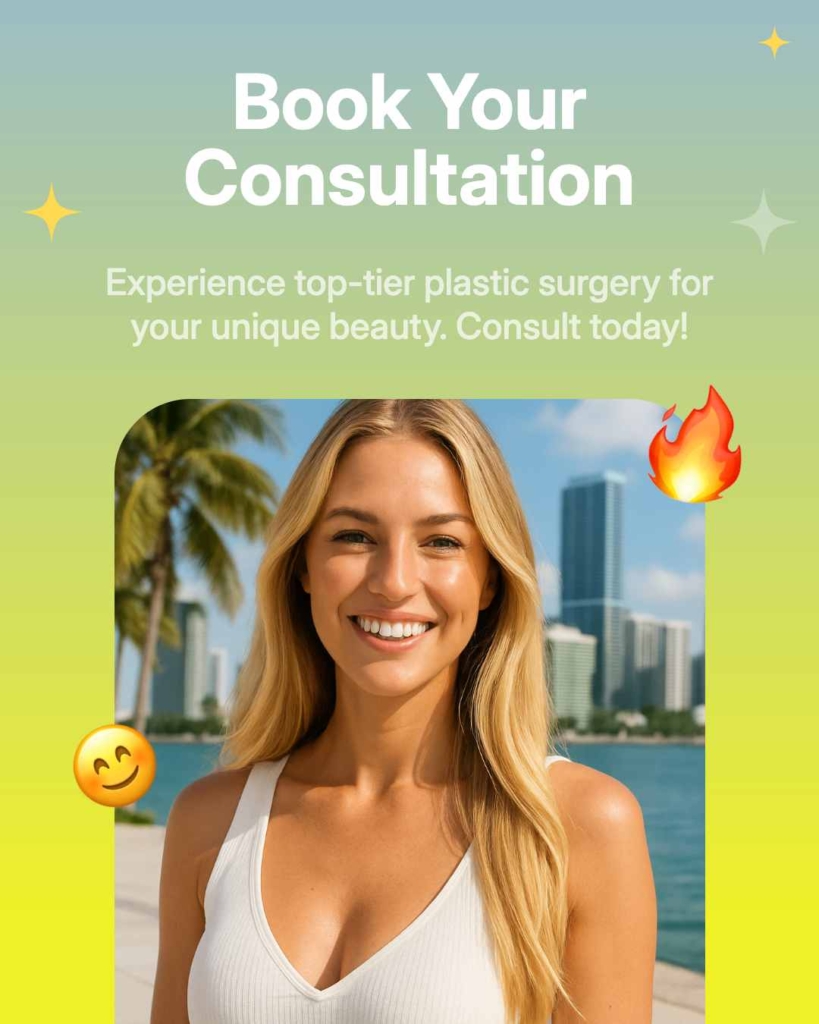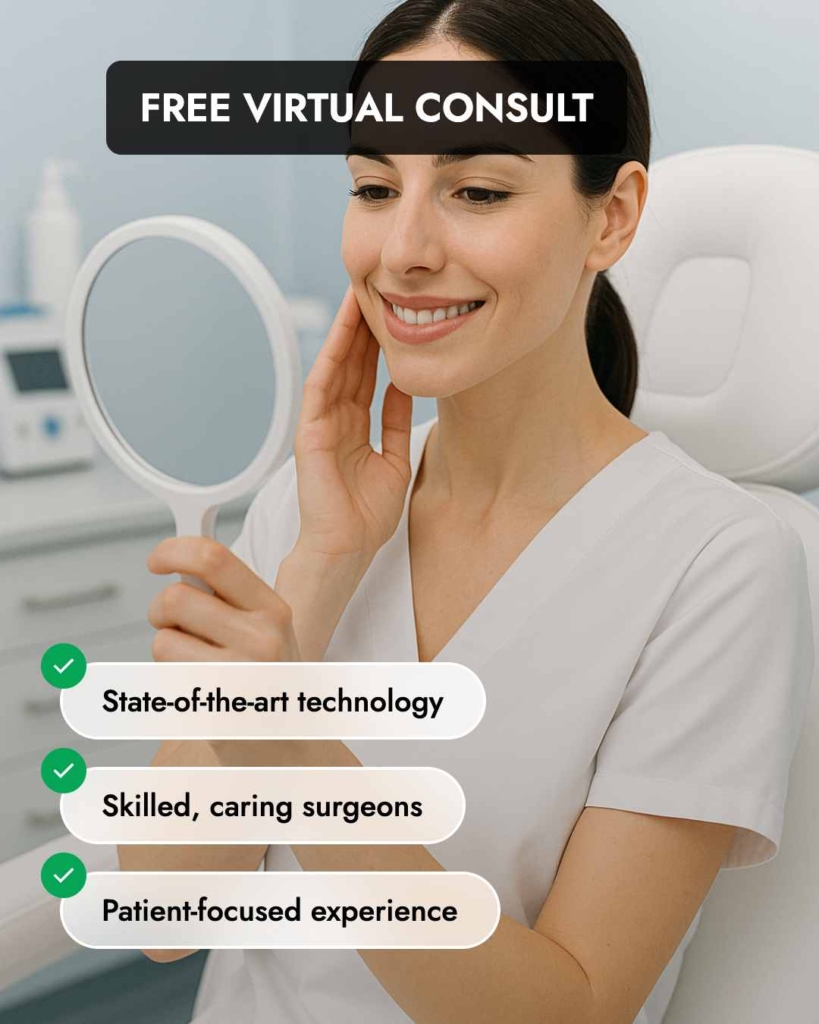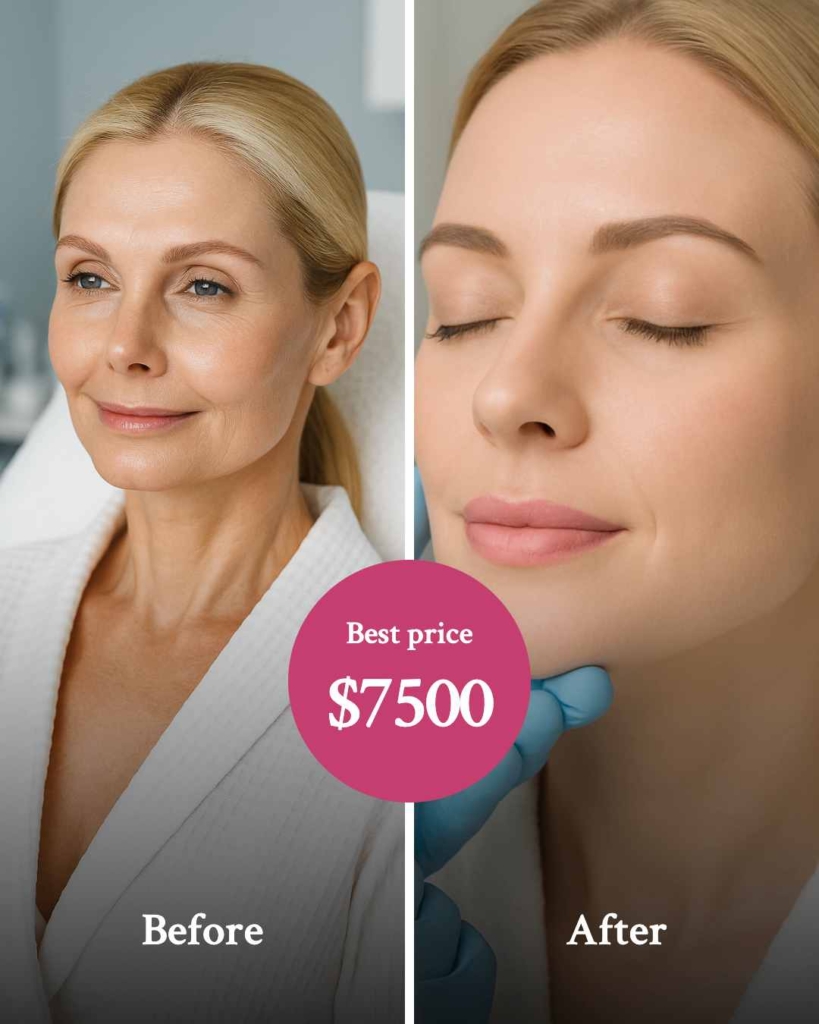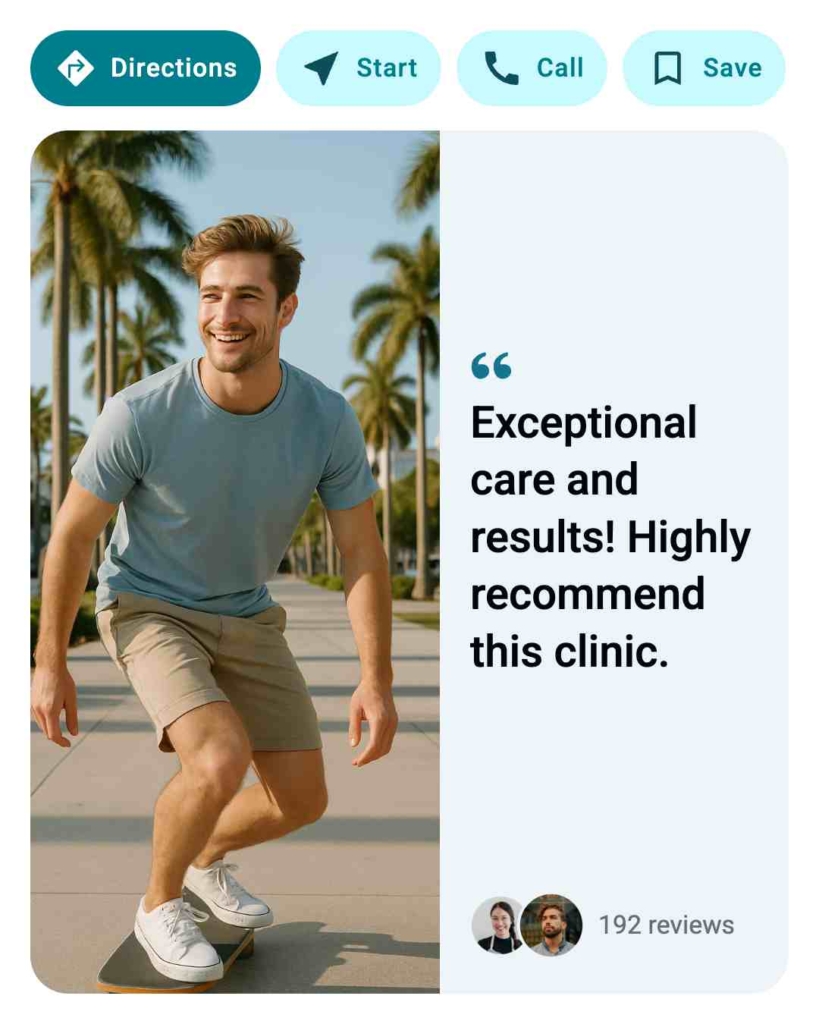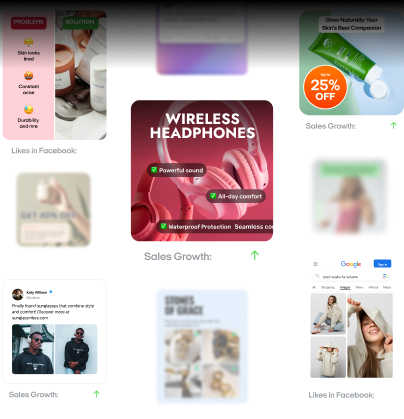Plastic surgery digital marketing: 7 key strategies that work
Boost your practice with proven plastic surgery digital marketing strategies. Discover 7 tactics to attract more patients and grow online.
Plastic surgery clinics compete in a fast-growing, digitally driven market. Search engines now generate three times more patient leads than referrals, making plastic surgery SEO, PPC, and reputation management critical to growth. As the market nears $48.84 billion by 2026, clinics with strong plastic surgery website design and targeted social media marketing will capture the demand, turning clicks into consultations with a fully integrated strategy.
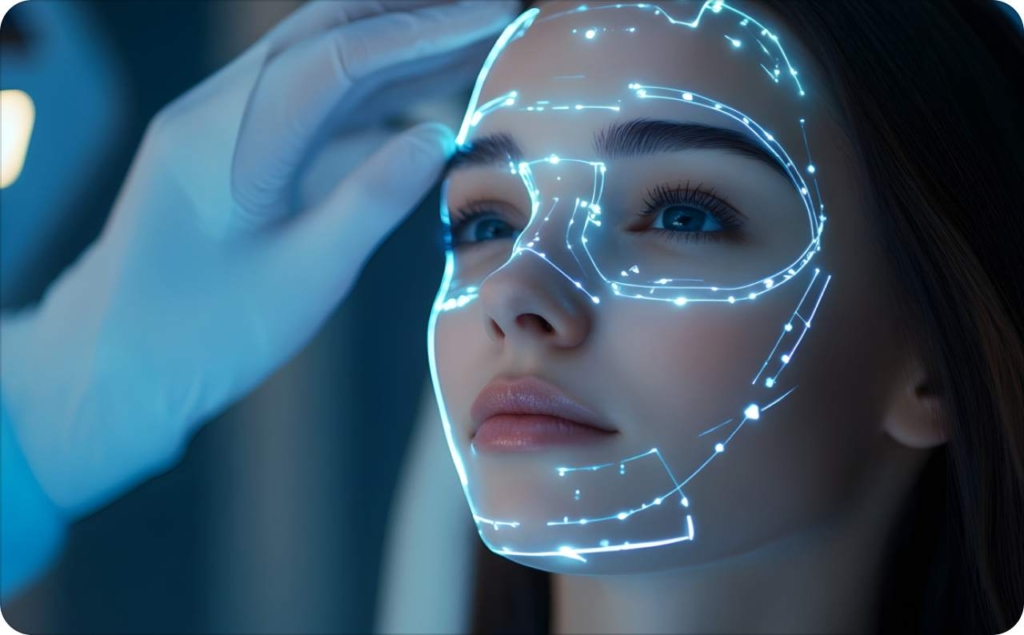
Understanding your ideal patient demographics
Effective plastic surgery digital marketing starts with understanding who your patients are. Demographics drive everything from messaging and design to media buying and content strategy. Without clarity on your ideal patient profile, even the best campaigns will miss the mark.
Age and gender trends in plastic surgery
Cosmetic surgery is no longer limited to women over 40. While women still account for most procedures, the male segment continues to grow, especially in hair restoration, eyelid surgery, and body contouring.
Millennials and Gen Z now represent a major share of demand, driven by interest in minimally invasive treatments like Botox, lip fillers, and rhinoplasty. Social media influence and early aesthetic enhancement motivate this younger demographic.
To compete, clinics must align plastic surgery branding and lead generation strategies with age-specific behaviors, adjusting platforms, visuals, and messaging to match each audience segment.
Motivations for seeking plastic surgery
While age and gender shape the “who,” motivations define the “why.” Patients pursue plastic surgery for reasons that range from post-pregnancy body restoration and career confidence to social pressure and personal empowerment.
A mother of three considering a tummy tuck isn’t responding to the same messaging as a 26-year-old looking for non-surgical jawline sculpting. Yet both are valid prospects and both require content that speaks directly to their intent. This is where your cosmetic surgery advertising must evolve beyond generic promises and address emotional triggers with precision.
In competitive markets, aligning your ad copy, before-and-after photos SEO, and testimonials with patient motivations is what separates a clinic with traffic from a clinic with booked consults.
Ultimately, when your digital assets speak to the right demographic, with the right emotional appeal, your plastic surgery SEO rankings start to generate real leads, not just clicks.
Key plastic surgery digital marketing strategies
Digital marketing is a competitive requirement. As patient journeys move online, clinics must master a blend of plastic surgery SEO, PPC advertising, reputation management, and conversion-focused web design to consistently attract and convert high-intent leads.
Optimize your website: Check UX, speed, booking
Your website is your most valuable digital asset and often the first impression a prospective patient has of your practice. In plastic surgery marketing, the website doesn’t just inform; it converts. A high-performance plastic surgery website design directly impacts lead generation, SEO rankings, and patient trust.
Why website performance matters
- Slow, outdated, or hard-to-navigate websites reduce trust and increase bounce rates, especially in high-stakes niches like cosmetic surgery.
- Google’s algorithm prioritizes fast-loading, mobile-optimized websites — a direct ranking factor for plastic surgery SEO.
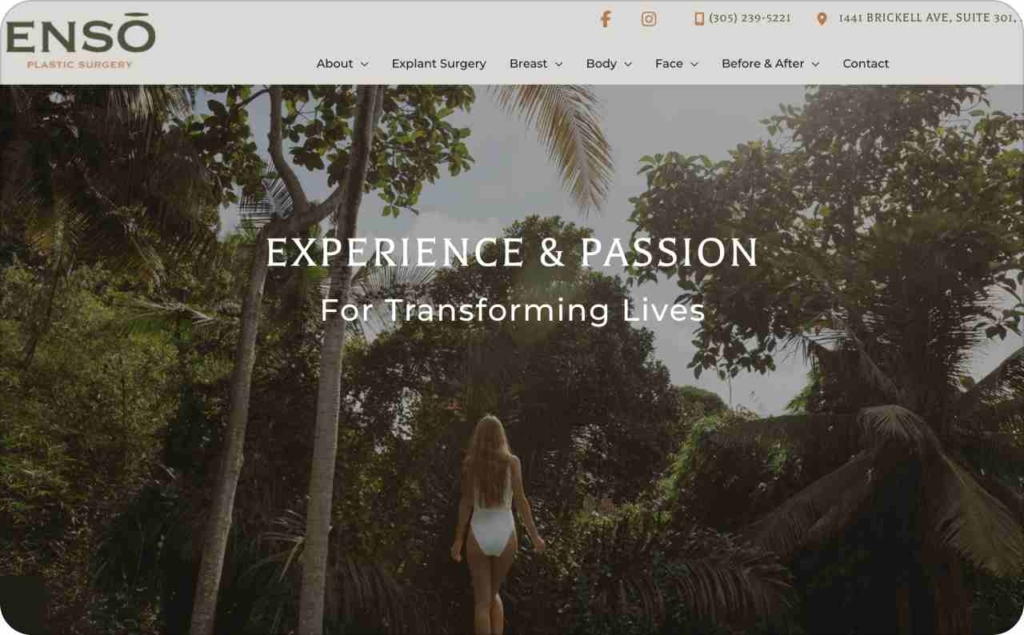
Photo source: Enso Plastic Surgery
UX and design best practices
To support your plastic surgery digital marketing strategy, your site should be:
- Easy to navigate
- Mobile-first
- Conversion-focused
This is essential for turning traffic into booked consultations and form the foundation of an effective plastic surgeon lead generation system.
Visuals that convert
Visual content is critical in cosmetic surgery advertising. Users want to see real outcomes, not stock images. Your site should feature:
- Before-and-after photo galleries optimized for SEO
- Clear distinctions between reconstructive and aesthetic procedures
- Proper labeling for procedures like rhinoplasty, non-surgical treatments, and breast augmentation ads
- Visuals that are retina-quality, mobile-scaled, and responsive across all devices
These assets directly influence plastic surgery branding, and also help improve time-on-site and engagement — important behavioral signals for SEO for plastic surgeons near me.
Technical and SEO essentials
To fully support your digital marketing strategies for plastic surgeons, your website should also include:
- Responsive design that passes Core Web Vitals
- SEO-optimized pages for each procedure
- Fast page load times
- Descriptive alt text on all images to improve accessibility and visual search relevance
- Clear internal linking and breadcrumb navigation to support plastic surgery SEO
Booking infrastructure that drives conversions
Strong UX must always lead to action. Build your site with:
- Embedded scheduling tools that allow patients to book directly from service pages
- Sticky CTAs that appear on every screen, especially on mobile
- Multiple conversion options: contact forms, instant booking, WhatsApp chat, or SMS links
- Automated follow-up flows for missed or abandoned bookings
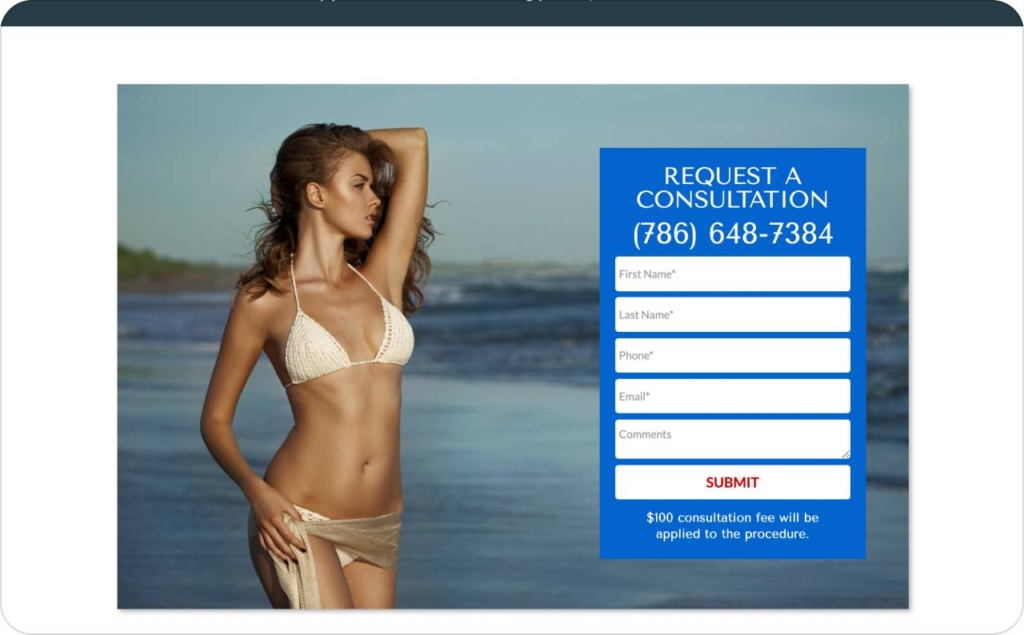
Photo source: Zuri Plastic Surgery
When your website is built to convert, your investments in plastic surgery PPC, social media marketing, and content campaigns all become more efficient and more profitable.
Improve your SEO
Once your plastic surgery website design is optimized for conversions, the next priority is driving visibility through search. This is where plastic surgery SEO becomes essential. Ranking high for the right keywords, not just general cosmetic terms, but also specific procedures and geographic phrases — means consistently attracting qualified, high-intent traffic without paid ads.
On-page and technical SEO: Your foundation
Before scaling content or ads, your site must be technically sound. A clean structure allows your keywords to work harder and improves performance across both search and user experience.
Core on-page and technical SEO elements include:
- Correcting URL structure
- Submitting an XML sitemap to Google Search Console
- Improving page speed and mobile responsiveness
- Creating unique, descriptive SEO titles and meta descriptions for each page
- Implementing a robust internal linking system to connect procedure and location pages
- Using schema markup for procedures, doctors, reviews, and locations
For example, optimizing these elements for a board-certified plastic surgeon in Boca Raton led to a 9.5% increase in traffic and displaced competing clinics from page one of search results.
Local SEO: Capture high-intent searches in your area
While broader SEO efforts build long-term growth, local SEO captures ready-to-book leads looking for providers nearby. In fact, 63% of patients prefer to choose a surgeon located close to home, making local visibility a powerful asset in your overall strategy.
Build your local SEO presence by:
- Claiming and optimizing your Google Business Profile
- Creating accurate citations across major directories
- Developing city-specific landing pages
- Embedding localized keywords throughout your content
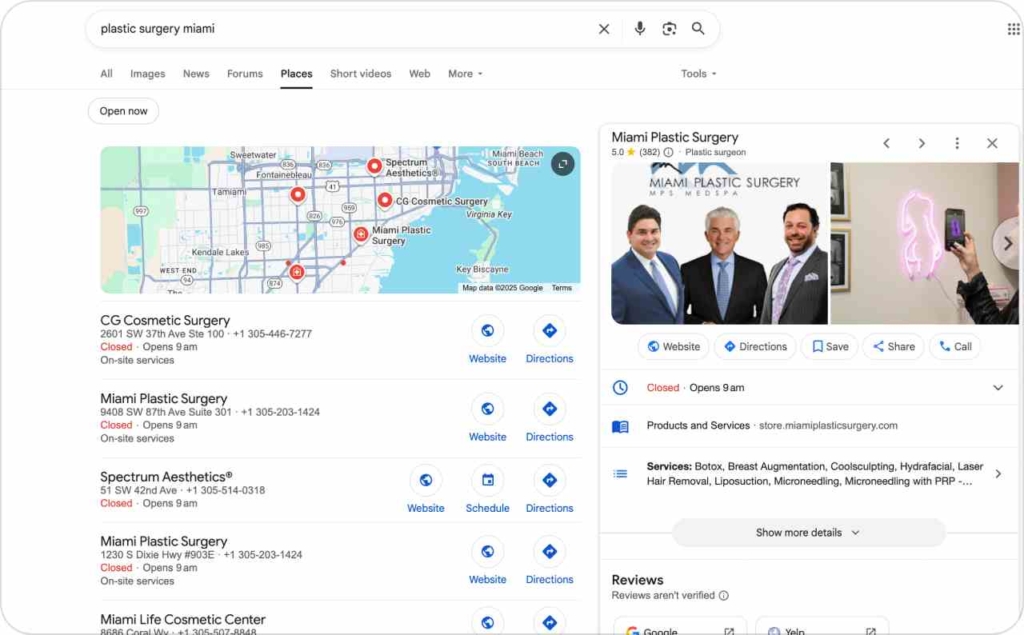
When paired with a high-converting site, robust local strategy, and a funnel-driven content system, SEO becomes one of the most cost-effective plastic surgery digital marketing services for long-term patient acquisition.
Don’t forget about social media marketing
Social platforms like Instagram, YouTube, and Facebook are core drivers of plastic surgery branding, lead generation, and patient engagement. However, in the healthcare space, social media comes with strict boundaries. Plastic surgeons must balance promotion with professionalism, especially when it comes to compliance.
Stay compliant with legal and ethical guidelines
Unlike typical eCommerce brands, board-certified plastic surgeon marketing must adhere to HIPAA, FTC, and state medical board regulations. Misuse of patient images, testimonials, or exaggerated claims can lead to serious penalties.
To stay compliant:
- Avoid incentivized influencer promotions unless structured carefully within legal limits
- Get written consent for all patient images or videos — verbal permission isn’t enough
- Follow American Society of Plastic Surgeons guidelines for medical marketing
- Disclose sponsored content and affiliate links transparently
Subcontracting social media to commission-based influencers without oversight can easily cross legal lines. Any promotional partnership must maintain full alignment with medical ethics and advertising standards.
Use Social Media to Amplify Evergreen Website Content
The most effective and compliant use of social platforms in plastic surgery social media marketing is to drive traffic to owned assets — your blog, procedure pages, or video content hosted on your website. Sharing evergreen content not only keeps your social presence active, but also contributes to improved plastic surgery SEO.
Examples of what to share:
- Blog articles covering recovery timelines, FAQs, and patient education
- YouTube videos walking through popular procedures like non-surgical treatments or rhinoplasty marketing
- Patient testimonials to build trust and authenticity
- High-quality before-and-after images with SEO-optimized alt text
Social engagement increases the likelihood that your content will be clicked, shared, and bookmarked — all positive signals that can improve your site’s position in search engine rankings. This is especially useful when running social media marketing for plastic surgery practices as part of a larger plastic surgeon lead generation strategy.
Manage online reputation
In aesthetic medicine, reputation is currency. For plastic and cosmetic surgeons, online reviews directly impact patient acquisition and long-term brand perception.Whether you’re promoting rhinoplasty, non-surgical treatments, or breast augmentation ads, your credibility often hinges on what previous patients say about you online.
Why reputation impacts plastic surgery branding
Unlike emergency care or insurance-driven medicine, cosmetic procedures are often elective and trust-based. Patients compare surgeons the way they’d compare luxury brands: closely, critically, and emotionally. A single unresolved negative review on Google or RealSelf can stall your plastic surgeon lead generation efforts, especially when prospects are considering multiple providers.
At the same time, positive reviews can dramatically improve your visibility and authority. Verified testimonials boost trust, improve CTR in search listings, and support plastic surgery reputation management across platforms.
Where reviews live and why it matters
Most patient reviews appear in your Google Business Profile, which ties directly into local SEO rankings. However, surgeons must also monitor:
- Social media platforms
- Review aggregators
- Consumer comparison sites
- Affiliate or influencer-led discussions
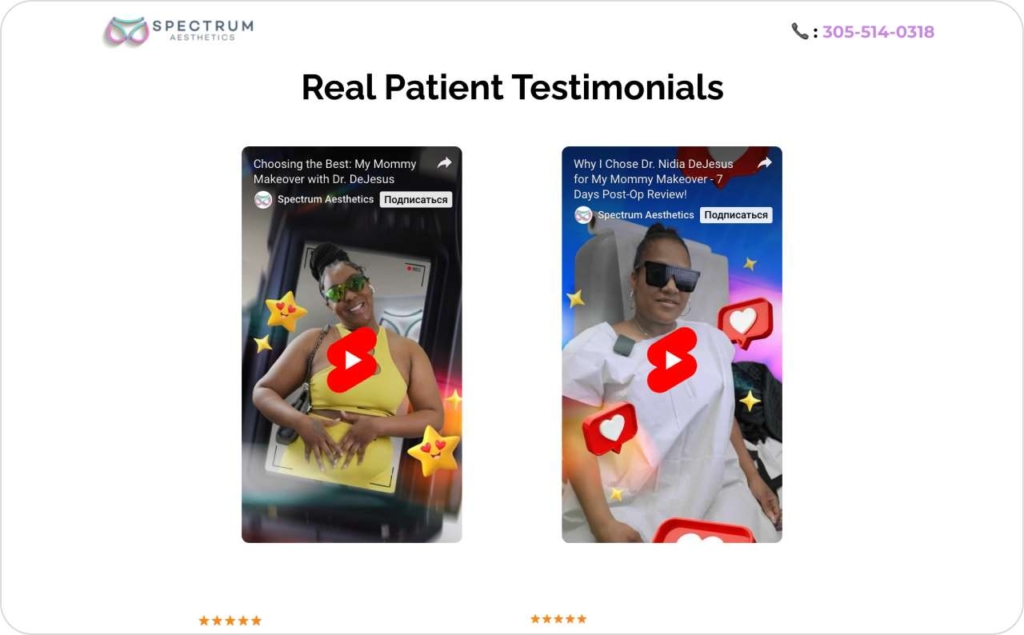
Photo source: Spectrum Aesthetics
If your clinic has multiple locations, each location page and GBP listing should be monitored independently. This is especially important for plastic surgery digital marketing services that include multi-location strategy.
Use paid advertising options
Paid digital advertising is a high-impact channel for plastic surgeon lead generation, allowing clinics to appear directly in front of prospective patients who are already searching for procedures. Through a mix of Google Ads, social media campaigns, and demographic targeting, plastic surgery PPC puts your brand in the decision path, often before your competitors even enter the conversation.
Search ads: High-intent targeting with Google & Bing
Google Ads and Microsoft Bing Ads let you appear at the top of search engine results pages for high-converting terms like:
- “breast augmentation surgeon near me”
- “rhinoplasty recovery time”
- “non-surgical facelift deals”
- “certified cosmetic surgeons in Miami”
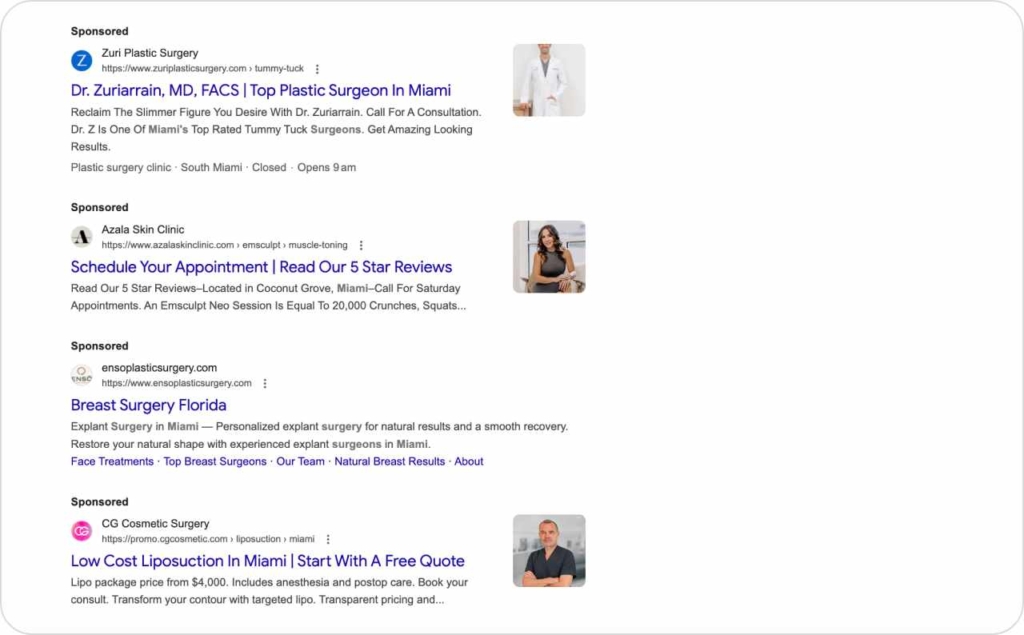
With plastic surgery PPC, you bid on keywords relevant to your services. You only pay when someone clicks on your ad, giving you immediate visibility in competitive search spaces.
Targeting capabilities include:
- Keyword-level bidding
- Geographic filters by city, ZIP code, or radius
- Device targeting for mobile users vs desktop traffic
- Ad extensions that highlight procedures, reviews, or booking CTAs
Google also supports retargeting, allowing you to follow up with people who’ve previously visited your site, especially powerful when paired with plastic surgery SEO landing pages optimized for conversion.
Social media ads: Broad awareness and targeted outreach
Social media marketing for plastic surgery practices thrives on platforms like Facebook, Instagram, and LinkedIn. While organic reach is limited, paid social ads offer sophisticated targeting to reach the right users at the right time.
- Facebook & Instagram: Best for visual campaigns. Ideal for promoting before-and-after photos, running time-sensitive promotions, or highlighting patient testimonials via video.
- LinkedIn: More niche, but useful for targeting affluent professionals, high-income audiences, or even cross-promotion with other wellness services.
Key targeting strategies on social platforms include:
- Demographic targeting: age, gender, income, marital status
- Location targeting: city, ZIP code, or local radius
- Interest targeting: connects to user interests like “cosmetic surgery” or “fitness influencers”
- Behavioral targeting: focuses on recent actions like “researched Botox pricing” or “clicked on aesthetic treatment guides”
Ad creatives should feature strong CTAs like “Book Your Consultation Today,” “Compare Breast Augmentation Packages,” or “See Real Patient Results” — each tailored to a specific stage in the funnel.
Integrate lead generation & conversion funnels
At the heart of every successful plastic surgery digital marketing strategy is a system built not just to attract attention, but to convert it. Without structured lead generation and optimized conversion funnels, even the most expensive plastic surgery PPC or social media ads will leak opportunities. Every click must have a clear path to action and that starts with infrastructure designed to capture, track, and convert patient interest in real time.
Why funnels matter in plastic surgery marketing
Unlike retail or low-stakes services, choosing a plastic surgeon is a multi-step, high-trust decision. Patients don’t just visit your website and book immediately, they browse, compare, revisit, and often delay action. A well-built funnel nurtures that interest from curiosity to consultation, capturing leads at every stage and guiding them toward booking.
In high-performing clinics, plastic surgeon lead generation is driven by intentional funnel design that connects ads, organic traffic, and landing pages with strong CTAs and follow-ups.
Key funnel components for plastic surgeons
- Conversion-Optimized Forms
- Call Tracking & Analytics
- Virtual Consultations
- CRM and Follow-Up Automation
Funnel strategy in action
A complete funnel in digital marketing for plastic surgeons might look like this:
- A user clicks a PPC ad for facelift consultation
- They land on a geo-targeted procedure page with before-and-after photos SEO
- A short form offers a free virtual consult
- Upon submission, the lead is logged in the CRM, triggering an automated text and internal alert
- If the user instead calls directly, call tracking ties the session to the ad campaign
- Post-consult, an email nurtures them with testimonials and care instructions, increasing confidence to book
In modern plastic surgery marketing, a strategic funnel transforms it into booked appointments, patient loyalty, and sustainable growth. If your clinic isn’t converting traffic into leads, you don’t need more clicks. You need a better funnel.
Create procedure-specific campaign playbooks
Generic marketing doesn’t work in plastic surgery. Patients are searching for highly specific procedures. Whether it’s rhinoplasty, breast augmentation, or Botox, each service has its own audience, emotional triggers, seasonal trends, and keyword behavior. That’s why plastic surgery digital marketing services must include dedicated, procedure-specific campaigns that align with intent, optimize conversion paths, and elevate plastic surgery branding around the treatments that drive revenue.
Why procedure-focused marketing works
- Increases relevance: Patients are more likely to convert when landing pages, ads, and visuals speak to their exact interest
- Improves Quality Scores and lowers PPC costs: Highly relevant ads connected to specific keywords boost performance
- Supports visual storytelling: Procedure-specific before-and-after photos SEO builds trust and authority faster than generic branding
- Enables advanced segmentation: You can track leads by service type, analyze ROAS per procedure, and adjust budget accordingly
Campaign playbook: Rhinoplasty marketing
Rhinoplasty attracts a younger demographic with high visual and emotional intent. The campaign strategy should focus on:
- Google Ads for keywords like “nose job before and after,” “closed vs open rhinoplasty,” and “rhinoplasty surgeon near me”
- Instagram Reels and TikToks that show before-and-after transitions, surgeon walkthroughs, or recovery tips
- Landing pages optimized for consultation booking with FAQs, timeline expectations, and downloadable guides
- Strong SEO focus on educational content like “What is the recovery time for rhinoplasty?” or “Is rhinoplasty safe for teens?”
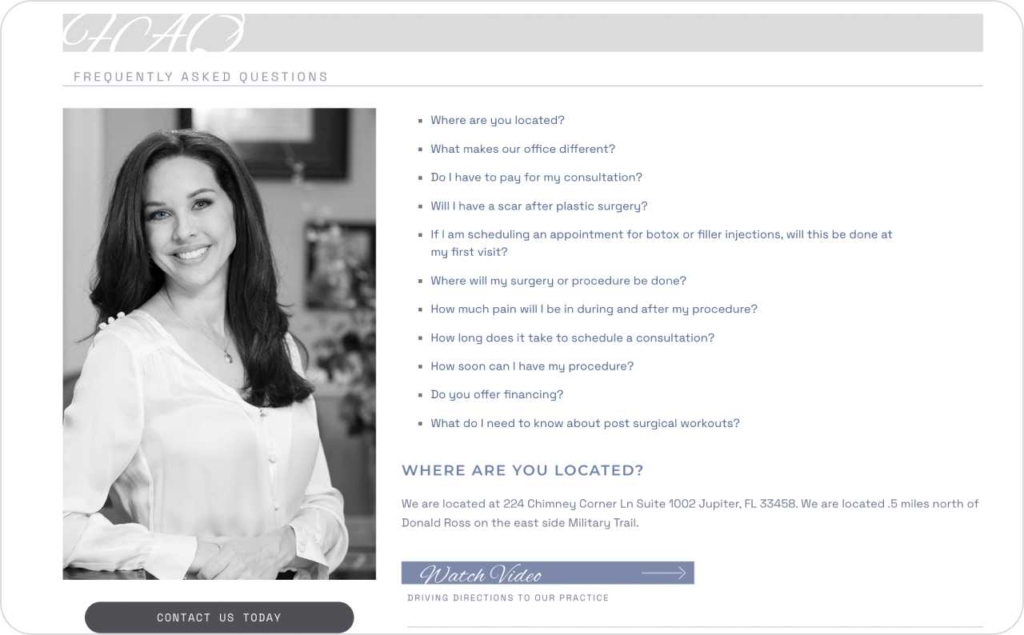
Photo source: Dr Dana MD
Campaign playbook: Breast augmentation ads
For breast augmentation, the goal is to combine lifestyle appeal with medical credibility.
- Use Facebook and Instagram Ads with lifestyle-focused imagery, promoting seasonal offers or payment options
- Target age groups 21–45 with demographic and interest filters like “fitness,” “mom blogs,” or “postpartum recovery”
- Build trust with patient testimonials and before-and-after photo galleries, including filterable sizes and implant types
- Retarget users who engage with your service pages using follow-up ads that offer virtual consults or downloadable lookbooks
Campaign playbook: Botox & non-surgical treatments SEO
Non-surgical treatments like Botox, fillers, and skin resurfacing often drive high volume with short decision cycles. Campaigns should emphasize convenience, affordability, and minimal downtime.
- Run Google Local Service Ads for “Botox near me” and “same-day Botox appointment”
- Push time-sensitive cosmetic surgery advertising promos through email and Instagram Stories
- Emphasize benefit-focused copy: “Look refreshed in 15 minutes,” “No downtime,” “First-time patient discounts”
- Create educational SEO content around questions like “How long does Botox last?” or “Is preventative Botox worth it?”
Regulatory compliance in digital marketing
Digital marketing for plastic surgeons operates under a unique set of legal and ethical obligations that directly influence how you can promote online. From federal privacy regulations to state-level “truth in advertising” laws, compliance isn’t optional. It’s foundational to sustainable, credible plastic surgery branding.
Why HIPAA status matters
Plastic surgeons who qualify as HIPAA-covered entities must follow strict federal guidelines about how patient data is used in marketing. Unlike general healthcare practices, many of the typical HIPAA marketing exemptions don’t apply to elective procedures. For example, promotions involving patient communications, testimonials, or email marketing may fall under HIPAA restrictions. This is why email campaigns are often discouraged in plastic surgery digital marketing services, unless managed through secure, opt-in systems and reviewed for compliance.
The role of certification & ethics guidelines
Even if a plastic surgeon is not classified as a HIPAA-covered entity, they are still bound by professional ethical standards. The American Society of Plastic Surgeons provides advertiser guidelines that align closely with Federal Trade Commission regulations on misleading marketing practices. These guidelines prohibit, for example, uncertified providers from marketing themselves as board-certified plastic surgeons — a practice still common in competitive markets.
Ethical digital campaigns must ensure that all credentials, procedures, and outcomes are accurately represented. Misleading cosmetic surgery advertising, even unintentionally, can result in FTC action, reputational damage, or license-related consequences.
Why state licensing laws also apply
In addition to federal rules, state laws introduce a second layer of complexity. Many states have enacted “truth in advertising” laws that require:
- Accurate representation of a surgeon’s title and certifications
- Clear opt-in mechanisms before patients receive marketing communications
- Enhanced privacy protections that go beyond HIPAA in some cases
These laws vary by state and can affect everything from how your consultation booking forms are designed to what language is used in plastic surgery PPC ads or before-and-after photos SEO.
For all these reasons, it’s often advisable for practices to work with a digital marketing agency that understands the intersection of plastic surgery, healthcare compliance, and regional advertising law. Regulatory missteps in marketing erode patient trust and weaken the very reputation your online presence is meant to build.
How to create ads for plastic surgery with an AI ad generator
Creating high-performing ads for plastic surgery services no longer requires a full creative team or hours of manual work. With Zeely, an all-in-one AI ad generator, plastic surgeons and weight loss companies can launch polished, on-brand campaigns in minutes.
Whether you’re promoting rhinoplasty consults, Botox specials, or non-surgical treatments, AI ad creation with Zeely makes the process faster, easier, and laser-focused on conversions.
See creative solutions for other industries
Step-by-step: Generate plastic surgery ads with Zeely
1. Paste your website or Shopify product URL. Zeely instantly imports your service details, offers, and branding elements. No need to manually enter data — AI pulls product info to auto-fill your ads, saving time and avoiding errors.
2. Choose your ad format. Select from 100+ static image templates, video formats, or from 150+ realistic AI avatars for video ads. Each format is pre-optimized for Meta platforms, ensuring maximum reach and engagement.
3. Let Zeely’s AI generate ad copy and visuals. The tool automatically writes persuasive headlines, body text, and CTAs while designing eye-catching visuals tailored to your audience. This AI script tool ensures every ad is medically appropriate and conversion-optimized.
4. Launch your campaign instantly via Meta integration. Push your ads live across Facebook and Instagram with a few clicks. Skip the manual setup — Zeely handles campaign structure, audience targeting, and placement.
Conclusion
Digital marketing is a primary growth engine. From procedure-specific SEO and high-converting websites to precision-targeted PPC and compliant social media strategies, every tactic must serve one goal: converting online visibility into booked consultations. Clinics that rely on generic campaigns or outdated platforms will continue to lose ground to competitors who invest in data-driven, localized, and patient-focused marketing.
A strategic approach, rooted in strong technical execution, regulatory awareness, and modern tools like Zeely, gives plastic surgeons full control over how they attract, engage, and convert patients in today’s digital-first world. Results are measurable in clicks, calls, consults, and revenue.
You may also like
Also recommended
